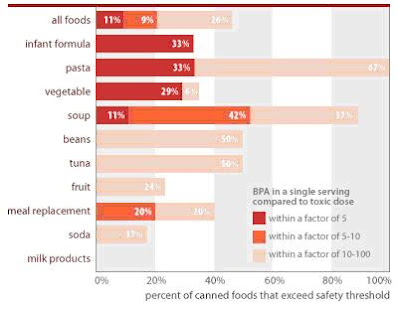Welcome to the latest column of my blog entitled 5
Answers. Although it seems like a
departure from my blog about all things organization, its purpose is to
organize the buzz and the facts available on a topic into a succinct
summary.
I will research topics from current events and pop
culture and post a concise article that provides the answers to 5 pertinent
questions on the topic. Please feel free
to request 5 Answers posts on topics about which you are interested to know
more. Most likely others will be
interested as well!

On October 4, 2011, California signed into
law the Toxin-Free Infants and Toddlers Act.
Effective July 1, 2013, the use of BPA will be banned from the
manufacture and sale of infant bottles and sippy cups in California.
I have been wary of BPA since my oldest daughter was born, but I haven’t
really researched the subject.
5 Answers about BPA:
1. What is BPA? BPA, or bisphenol A, is an ingredient
in many plastic household items, canned goods, and electronics.
2. Where is BPA found? BPA can be found in polycarbonate plastic, epoxy
resins and thermal paper (such as credit card receipts). BPA is also used to make some types of PVC.
Polycarbonate
(PC) plastics should be marked with the recycling symbol 7, which is the catch-all
or “other” category of plastics. There
may also be a small ‘PC’ mark near the recycling symbol. PC plastics are clear; if the plastic is
opaque, it is probably not PC. PC plastics
are widely used in infant bottles, water bottles, tableware, and plastic toys. In a Harvard study, BPA levels measured an
average of 69% higher after drinking water from polycarbonate plastic bottles
compared with stainless steel bottles.1
Epoxy
resin lines most metal canned food and drink items, including canned
vegetables, soups and infant formula.
3. What are the effects of BPA exposure? BPA belongs to a class of chemicals called
endocrine disruptors. BPA looks like
estrogen, so it mimics the actions of estrogen in the body, but it is more problematic because it isn't actually estrogen.
BPA-exposure
is difficult for scientists to study in humans, because we are all exposed to
it. In a CDC study, BPA was detected in
the urine of 93% of 2,517 participants tested!2
BPA
has been linked to brain development and behavioral problems, heart disease,
diabetes, cancers (specifically breast, liver and prostate), and early-onset
puberty.
4. How much BPA exposure can we get from canned goods? As
shown in the following figure, analysis of BPA testing shows that 1 in 10 cans
of food (any kind) and 1 in 3 cans of infant formula exceeds the government’s
current safety threshold for BPA exposure (and were within a factor of 5 of the dose known to be toxic).3 Acidic
or fatty canned foods such as tomatoes and beans are likely to contain more leached
BPA.2
Summary
of Findings: Percent of canned foods tested in which BPA-levels exceeded safety
thresholds
Borrowed
From: http://www.ewg.org/files/bpa_chart4.jpg
Recent research has suggested that the current
safety threshold may even need to be lowered to prevent harmful effects listed
in the previous section.4,5 In
response to this concern, government agencies are sponsoring millions of
dollars of research into the effects of BPA.
5. How can we avoid BPA exposure? Many
food containers and plastics for children are marked BPA-free. If the plastic has a recycling code, avoid
type 7 (especially if also marked ‘PC’) and type 3 (PVC). Recycle any plastic baby bottles or other
food containers if they are scratched, as it becomes easier for chemicals to
leach out when scratched. Also avoid
microwaving food in plastic containers.
Opt
for fresh or frozen fruits and vegetables instead of canned ones. Many soups are available in cardboard
packaging. Eden Organic makes canned beans in BPA-free cans and tomatoes and tomato sauces in glass
jars. Use powdered infant formula
instead of liquid if breastfeeding doesn’t work for you.
Use
reusable stainless steel containers for on-the-go water instead of plastic water
bottles (unless they are marked BPA-free).
And always opt for reusable instead of disposable containers.
Please comment with your
thoughts on BPA and other ideas for how to avoid BPA.
References:
3 http://www.ewg.org/node/20936 - “EWG calculated people's BPA exposures from canned food using the
following assumptions: Calculations reflect a single adult serving, using label
serving size and body weight of 60 kg (132 lbs); exposures for concentrated
infant formula is calculated for exclusively formula-fed infant using average
3-month-old body weight (6 kg or 13 lbs) and average daily formula ingestion
(840 g or 30 oz); formula is assumed diluted with water free of BPA. Estimated
single-serving exposures are compared against BPA dose of 2 ug/kg/d linked in
lab studies to permanent damage of reproductive system from in utero
exposures and referenced as "toxic dose" in [the figure].”








